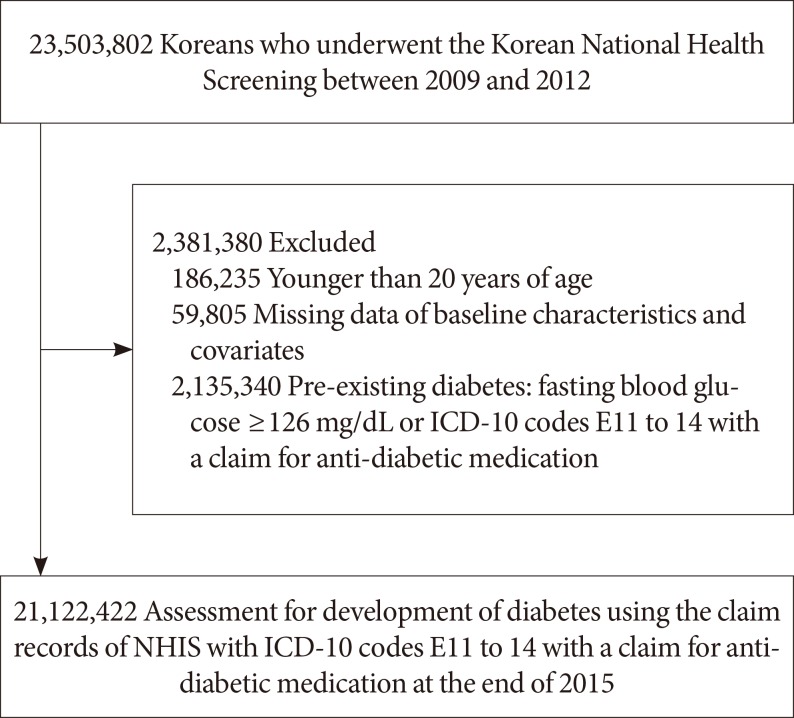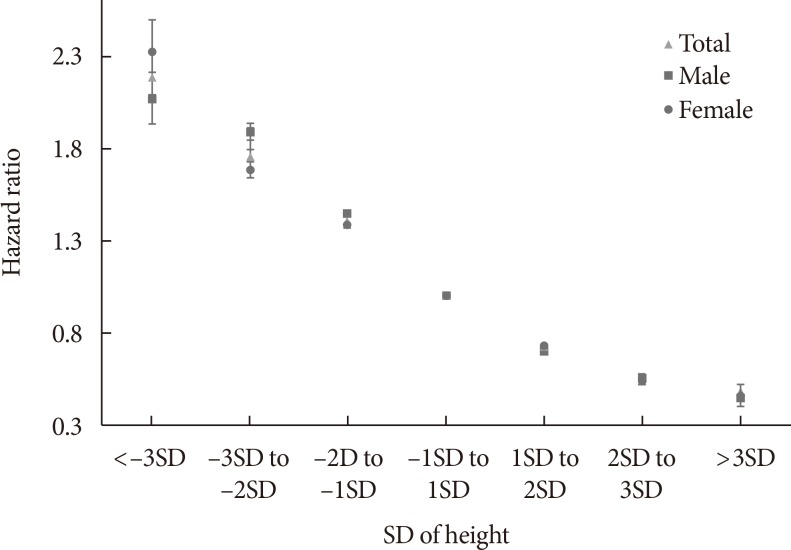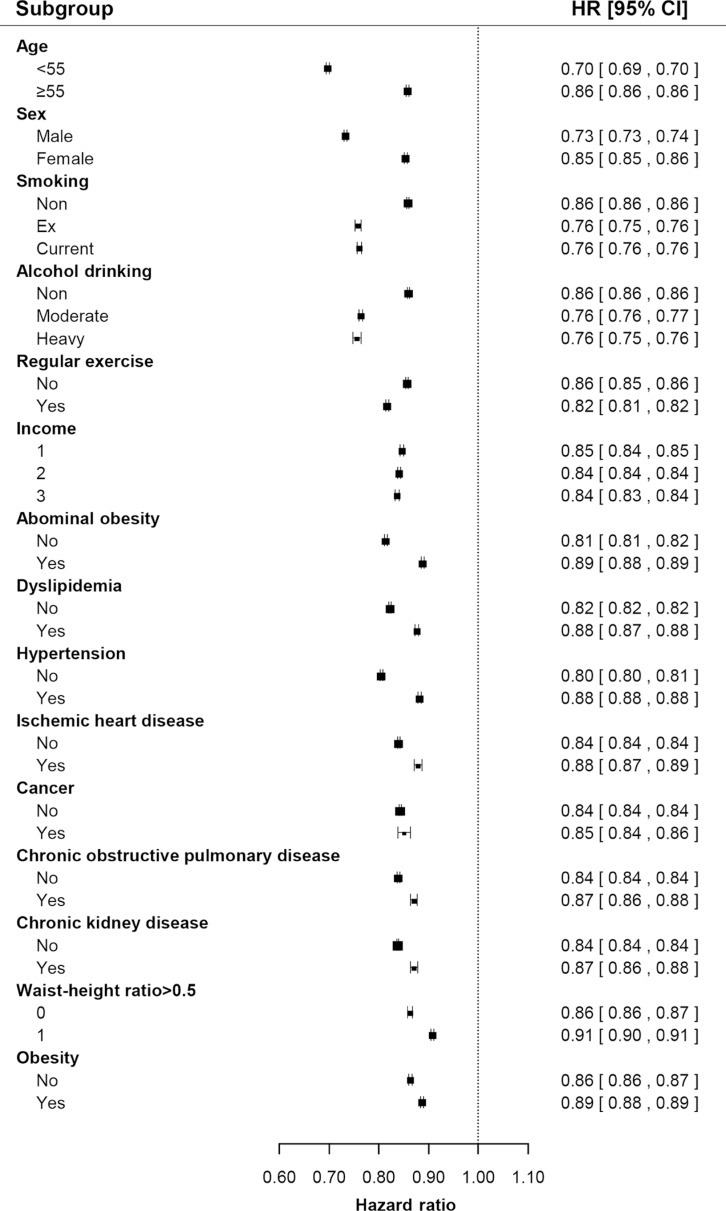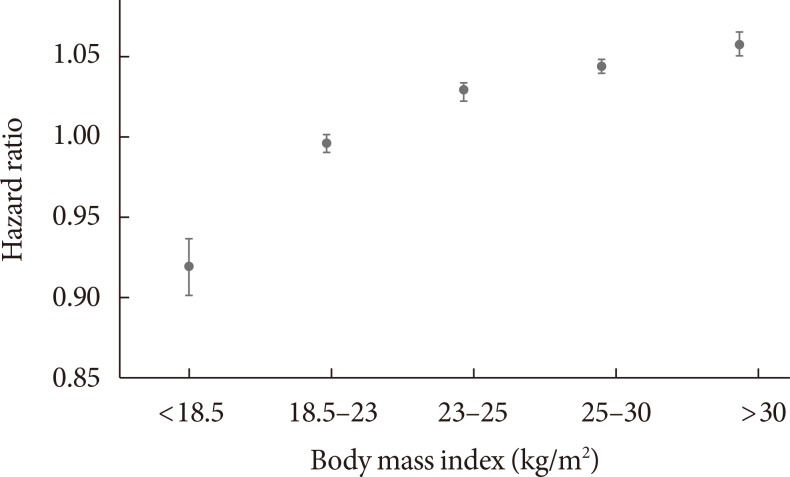Diabetes Metab J.
2019 Dec;43(6):794-803. 10.4093/dmj.2018.0184.
Relation between Baseline Height and New Diabetes Development: A Nationwide Population-Based Study
- Affiliations
-
- 1Division of Endocrinology and Metabolism, Department of Internal Medicine, Kangbuk Samsung Hospital, Sungkyunkwan University School of Medicine, Seoul, Korea. drlwy@hanmail.net
- 2Department of Biostatistics, Biomedicine & Health Sciences, College of Medicine, The Catholic University of Korea, Seoul, Korea.
- 3Department of Family Medicine, Korea University Anam Hospital, Korea University College of Medicine, Seoul, Korea.
- KMID: 2466501
- DOI: http://doi.org/10.4093/dmj.2018.0184
Abstract
- BACKGROUND
Short stature and leg length are associated with risk of diabetes and obesity. However, it remains unclear whether this association is observed in Asians. We evaluated the association between short stature and increased risk for diabetes using the Korean National Health Screening (KNHS) dataset.
METHODS
We assessed diabetes development in 2015 in 21,122,422 non-diabetic Koreans (mean age 43 years) enrolled in KNHS from 2009 to 2012 using International Classification of Diseases 10th (ICD-10) code and anti-diabetic medication prescription. Risk was measured in age- and sex-dependent quintile groups of baseline height (20 to 39, 40 to 59, ≥60 years).
RESULTS
During median 5.6-year follow-up, 532,918 cases (2.5%) of diabetes occurred. The hazard ratio (HR) for diabetes development gradually increased from the 5th (reference) to 1st quintile group of baseline height after adjustment for confounding factors (1.000, 1.076 [1.067 to 1.085], 1.097 [1.088 to 1.107], 1.141 [1.132 to 1.151], 1.234 [1.224 to 1.244]), with similar results in analysis by sex. The HR per 5 cm height increase was lower than 1.00 only in those with fasting blood glucose (FBG) below 100 mg/dL (0.979 [0.975 to 0.983]), and in lean individuals (body mass index [BMI] 18.5 to 23 kg/m²: 0.993 [0.988 to 0.998]; BMI <18.5 kg/m²: 0.918 [0.9 to 0.935]).
CONCLUSION
Height was inversely associated with diabetes risk in this nationwide study of Korean adults. This association did not differ by sex, and was significant in lean individuals and those with normal FBG levels.
Keyword
MeSH Terms
Figure
Cited by 1 articles
-
Risk of Diabetes in Subjects with Positive Fecal Immunochemical Test: A Nationwide Population-Based Study
Kwang Woo Kim, Hyun Jung Lee, Kyungdo Han, Jung Min Moon, Seung Wook Hong, Eun Ae Kang, Jooyoung Lee, Hosim Soh, Seong-Joon Koh, Jong Pil Im, Joo Sung Kim
Endocrinol Metab. 2021;36(5):1069-1077. doi: 10.3803/EnM.2021.1119.
Reference
-
1. International Diabetes Federation: Epidemiology & research. cited 2019 Jan 16. Available from: https://www.idf.org/e-library/epidemiology-research/diabetes-atlas.html.4. Ng M, Fleming T, Robinson M, Thomson B, Graetz N, Margono C, Mullany EC, Biryukov S, Abbafati C, Abera SF, Abraham JP, Abu-Rmeileh NM, Achoki T, AlBuhairan FS, Alemu ZA, Alfonso R, Ali MK, Ali R, Guzman NA, Ammar W, Anwari P, Banerjee A, Barquera S, Basu S, Bennett DA, Bhutta Z, Blore J, Cabral N, Nonato IC, Chang JC, Chowdhury R, Courville KJ, Criqui MH, Cundiff DK, Dabhadkar KC, Dandona L, Davis A, Dayama A, Dharmaratne SD, Ding EL, Durrani AM, Esteghamati A, Farzadfar F, Fay DF, Feigin VL, Flaxman A, Forouzanfar MH, Goto A, Green MA, Gupta R, Hafezi-Nejad N, Hankey GJ, Harewood HC, Havmoeller R, Hay S, Hernandez L, Husseini A, Idrisov BT, Ikeda N, Islami F, Jahangir E, Jassal SK, Jee SH, Jeffreys M, Jonas JB, Kabagambe EK, Khalifa SE, Kengne AP, Khader YS, Khang YH, Kim D, Kimokoti RW, Kinge JM, Kokubo Y, Kosen S, Kwan G, Lai T, Leinsalu M, Li Y, Liang X, Liu S, Logroscino G, Lotufo PA, Lu Y, Ma J, Mainoo NK, Mensah GA, Merriman TR, Mokdad AH, Moschandreas J, Naghavi M, Naheed A, Nand D, Narayan KM, Nelson EL, Neuhouser ML, Nisar MI, Ohkubo T, Oti SO, Pedroza A, Prabhakaran D, Roy N, Sampson U, Seo H, Sepanlou SG, Shibuya K, Shiri R, Shiue I, Singh GM, Singh JA, Skirbekk V, Stapelberg NJ, Sturua L, Sykes BL, Tobias M, Tran BX, Trasande L, Toyoshima H, van de Vijver S, Vasankari TJ, Veerman JL, Velasquez-Melendez G, Vlassov VV, Vollset SE, Vos T, Wang C, Wang X, Weiderpass E, Werdecker A, Wright JL, Yang YC, Yatsuya H, Yoon J, Yoon SJ, Zhao Y, Zhou M, Zhu S, Lopez AD, Murray CJ, Gakidou E. Global, regional, and national prevalence of overweight and obesity in children and adults during 1980-2013: a systematic analysis for the Global Burden of Disease Study 2013. Lancet. 2014; 384:766–781. PMID: 24880830.
Article5. Ohn JH, Kwak SH, Cho YM, Lim S, Jang HC, Park KS, Cho NH. 10-Year trajectory of β-cell function and insulin sensitivity in the development of type 2 diabetes: a community-based prospective cohort study. Lancet Diabetes Endocrinol. 2016; 4:27–34. PMID: 26577716.
Article6. Lee K, Song YM, Sung J. Which obesity indicators are better predictors of metabolic risk?: healthy twin study. Obesity (Silver Spring). 2008; 16:834–840. PMID: 18239595.
Article7. Son YJ, Kim J, Park HJ, Park SE, Park CY, Lee WY, Oh KW, Park SW, Rhee EJ. Association of waist-height ratio with diabetes risk: a 4-year longitudinal retrospective study. Endocrinol Metab (Seoul). 2016; 31:127–133. PMID: 26754587.
Article8. Mbanya VN, Kengne AP, Mbanya JC, Akhtar H. Body mass index, waist circumference, hip circumference, waist-hip-ratio and waist-height-ratio: which is the better discriminator of prevalent screen-detected diabetes in a Cameroonian population? Diabetes Res Clin Pract. 2015; 108:23–30. PMID: 25700625.
Article9. Njølstad I, Arnesen E, Lund-Larsen PG. Sex differences in risk factors for clinical diabetes mellitus in a general population: a 12-year follow-up of the Finnmark Study. Am J Epidemiol. 1998; 147:49–58. PMID: 9440398.10. Lorenzo C, Williams K, Stern MP, Haffner SM. Height, ethnicity, and the incidence of diabetes: the San Antonio Heart Study. Metabolism. 2009; 58:1530–1535. PMID: 19586642.
Article11. Janghorbani M, Amini M. Associations of hip circumference and height with incidence of type 2 diabetes: the Isfahan diabetes prevention study. Acta Diabetol. 2012; 49 Suppl 1:S107–S114. PMID: 22080142.
Article12. Janghorbani M, Momeni F, Dehghani M. Hip circumference, height and risk of type 2 diabetes: systematic review and meta-analysis. Obes Rev. 2012; 13:1172–1181. PMID: 22943765.
Article13. Song SO, Jung CH, Song YD, Park CY, Kwon HS, Cha BS, Park JY, Lee KU, Ko KS, Lee BW. Background and data configuration process of a nationwide population-based study using the korean national health insurance system. Diabetes Metab J. 2014; 38:395–403. PMID: 25349827.
Article14. Kim YH, Kim SM, Han KD, Son JW, Lee SS, Oh SW, Lee WY, Yoo SJ. Taskforce Team of the Obesity Fact Sheet of the Korean Society for the Study of Obesity. Change in weight and body mass index associated with all-cause mortality in Korea: a nationwide longitudinal study. J Clin Endocrinol Metab. 2017; 102:4041–4050. PMID: 28938403.
Article15. Levey AS, Bosch JP, Lewis JB, Greene T, Rogers N, Roth D. A more accurate method to estimate glomerular filtration rate from serum creatinine: a new prediction equation. Modification of Diet in Renal Disease Study Group. Ann Intern Med. 1999; 130:461–470. PMID: 10075613.16. Han TS, Feskens EJ, Lean ME, Seidell JC. Associations of body composition with type 2 diabetes mellitus. Diabet Med. 1998; 15:129–135. PMID: 9507913.
Article17. Bozorgmanesh M, Hadaegh F, Zabetian A, Azizi F. Impact of hip circumference and height on incident diabetes: results from 6-year follow-up in the Tehran Lipid and Glucose Study. Diabet Med. 2011; 28:1330–1336. PMID: 21627688.
Article18. Hebert PR, Rich-Edwards JW, Manson JE, Ridker PM, Cook NR, O'Connor GT, Buring JE, Hennekens CH. Height and incidence of cardiovascular disease in male physicians. Circulation. 1993; 88(4 Pt 1):1437–1443. PMID: 8403290.
Article19. Silventoinen K, Zdravkovic S, Skytthe A, McCarron P, Herskind AM, Koskenvuo M, de Faire U, Pedersen N, Christensen K, Kaprio J. GenomEUtwin Project. Association between height and coronary heart disease mortality: a prospective study of 35,000 twin pairs. Am J Epidemiol. 2006; 163:615–621. PMID: 16484449.
Article20. Song YM, Smith GD, Sung J. Adult height and cause-specific mortality: a large prospective study of South Korean men. Am J Epidemiol. 2003; 158:479–485. PMID: 12936903.
Article21. Hirschhorn JN, Lindgren CM, Daly MJ, Kirby A, Schaffner SF, Burtt NP, Altshuler D, Parker A, Rioux JD, Platko J, Gaudet D, Hudson TJ, Groop LC, Lander ES. Genomewide linkage analysis of stature in multiple populations reveals several regions with evidence of linkage to adult height. Am J Hum Genet. 2001; 69:106–116. PMID: 11410839.
Article22. Park HS, Yim KS, Cho SI. Gender differences in familial aggregation of obesity-related phenotypes and dietary intake patterns in Korean families. Ann Epidemiol. 2004; 14:486–491. PMID: 15301785.
Article23. Li JK, Ng MC, So WY, Chiu CK, Ozaki R, Tong PC, Cockram CS, Chan JC. Phenotypic and genetic clustering of diabetes and metabolic syndrome in Chinese families with type 2 diabetes mellitus. Diabetes Metab Res Rev. 2006; 22:46–52. PMID: 16021651.
Article24. Lawlor DA, Ebrahim S, Davey Smith G. The association between components of adult height and type II diabetes and insulin resistance: British Women's Heart and Health Study. Diabetologia. 2002; 45:1097–1106. PMID: 12189439.
Article25. Liu J, Tan H, Jeynes B. Is femur length the key height component in risk prediction of type 2 diabetes among adults? Diabetes Care. 2009; 32:739–740. PMID: 19171722.
Article26. Sandhu MS, Heald AH, Gibson JM, Cruickshank JK, Dunger DB, Wareham NJ. Circulating concentrations of insulin-like growth factor-I and development of glucose intolerance: a prospective observational study. Lancet. 2002; 359:1740–1745. PMID: 12049864.
Article27. Asao K, Kao WH, Baptiste-Roberts K, Bandeen-Roche K, Erlinger TP, Brancati FL. Short stature and the risk of adiposity, insulin resistance, and type 2 diabetes in middle age: the Third National Health and Nutrition Examination Survey (NHANES III), 1988-1994. Diabetes Care. 2006; 29:1632–1637. PMID: 16801590.
- Full Text Links
- Actions
-
Cited
- CITED
-
- Close
- Share
- Similar articles
-
- Increased Risk of Cardiovascular Disease and Mortality in Patients with Diabetes and Coexisting Depression: A Nationwide Population-Based Cohort Study (Diabetes Metab J 2021;45:379-89)
- Increased Risk of Cardiovascular Disease and Mortality in Patients with Diabetes and Coexisting Depression: A Nationwide Population-Based Cohort Study (Diabetes Metab J 2021;45:379-89)
- Data Analytic Process of a Nationwide Population-Based Study Using National Health Information Database Established by National Health Insurance Service
- Association of Waist-Height Ratio with Diabetes Risk: A 4-Year Longitudinal Retrospective Study
- Prevalence of Diabetic Retinopathy in Undiagnosed Diabetic Patients: A Nationwide Population-Based Study





